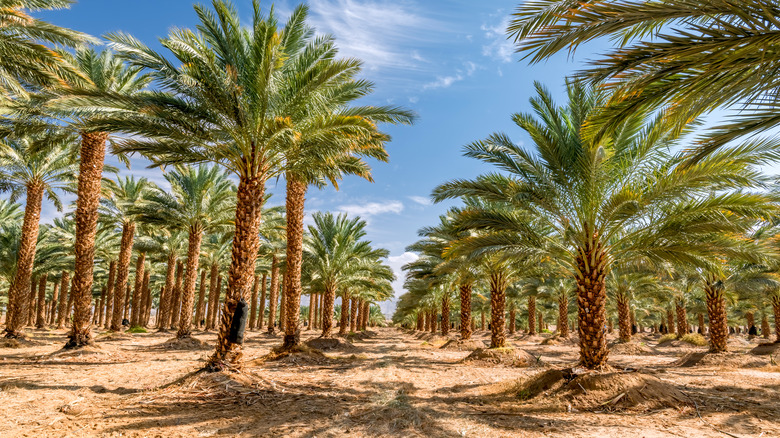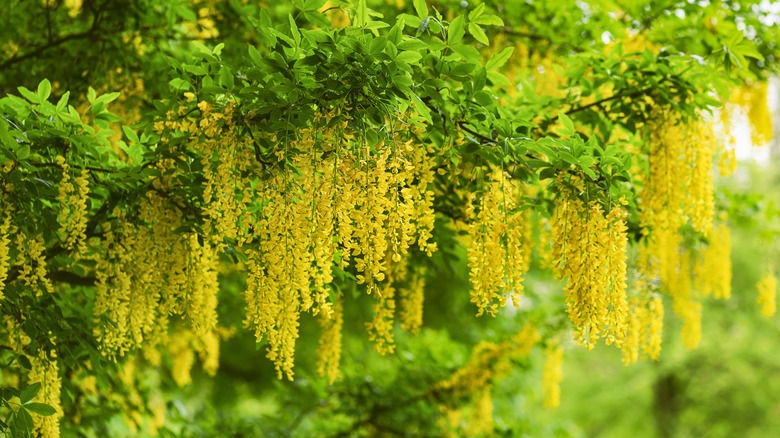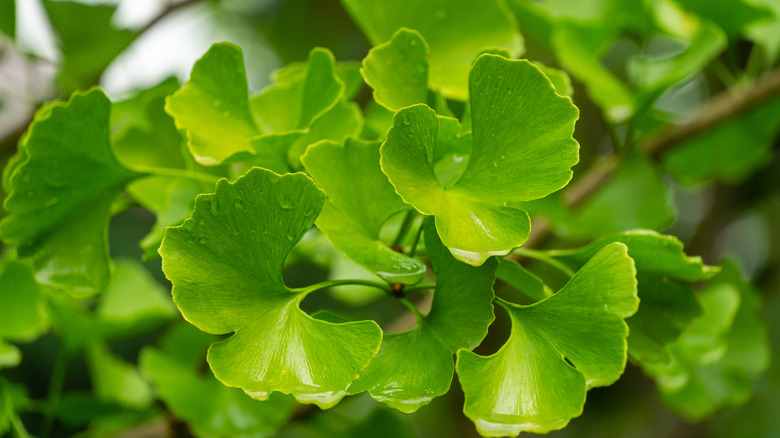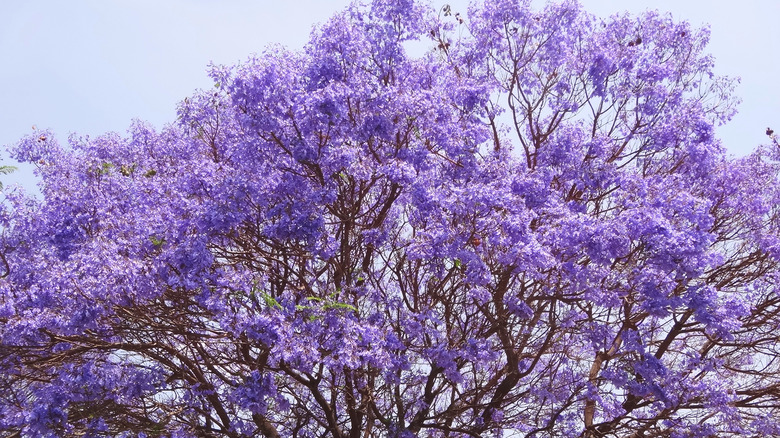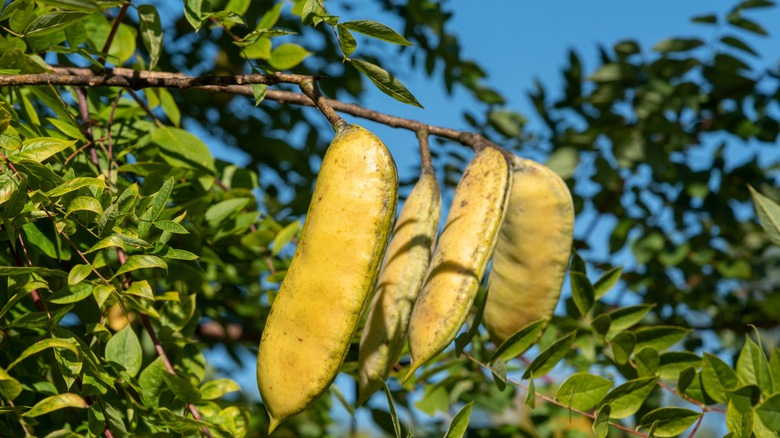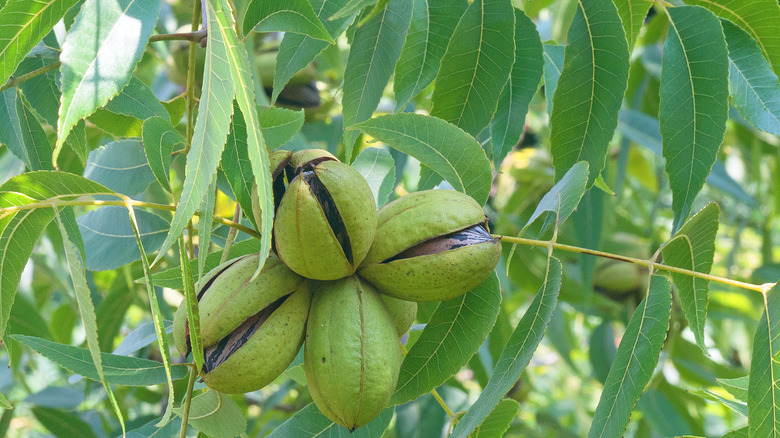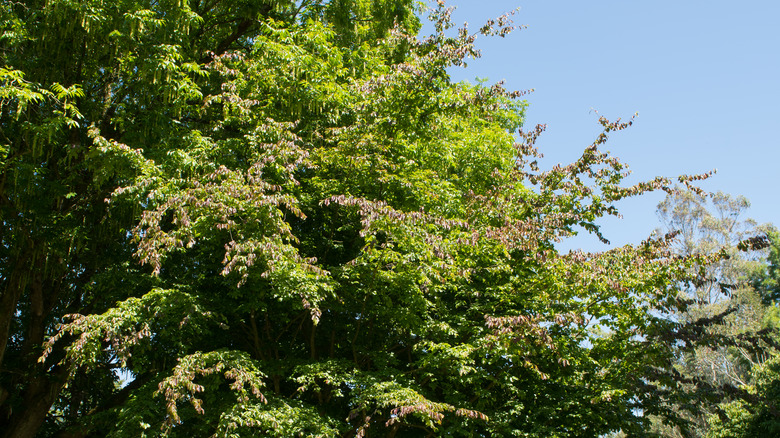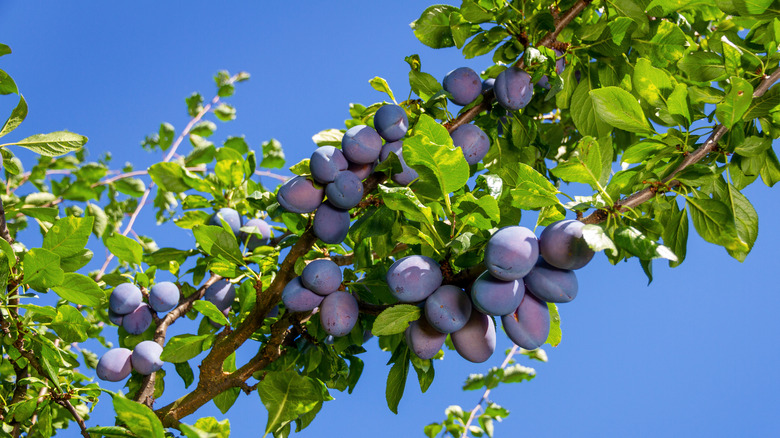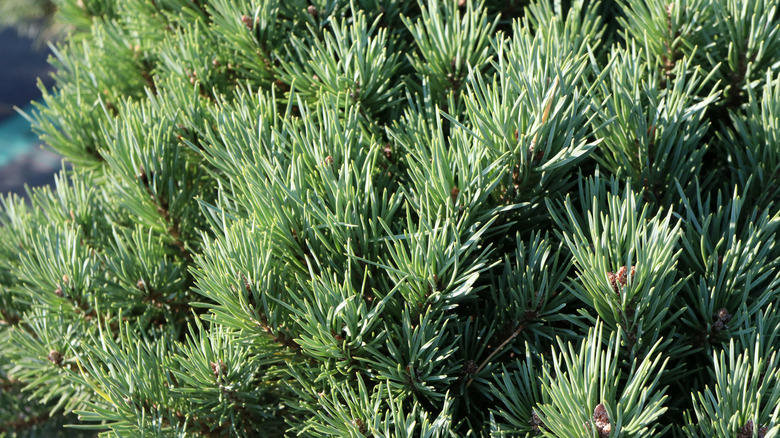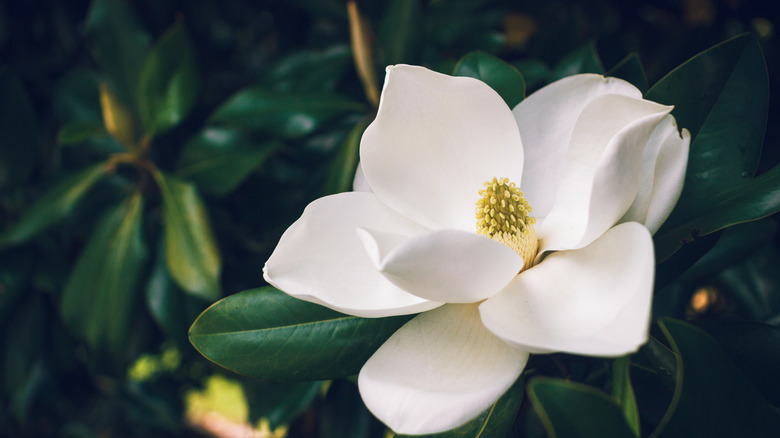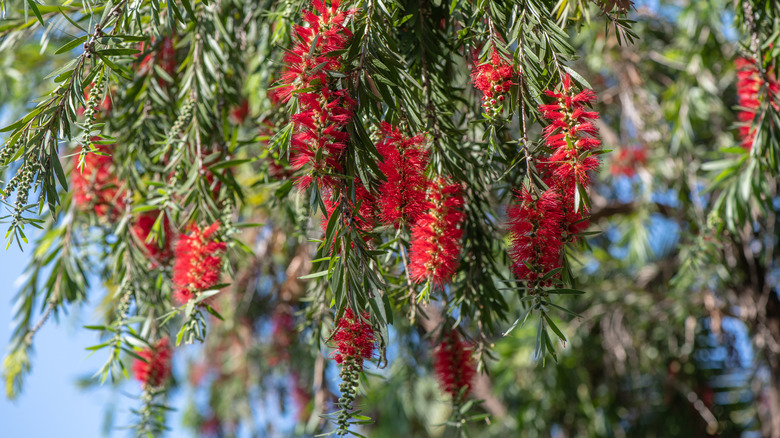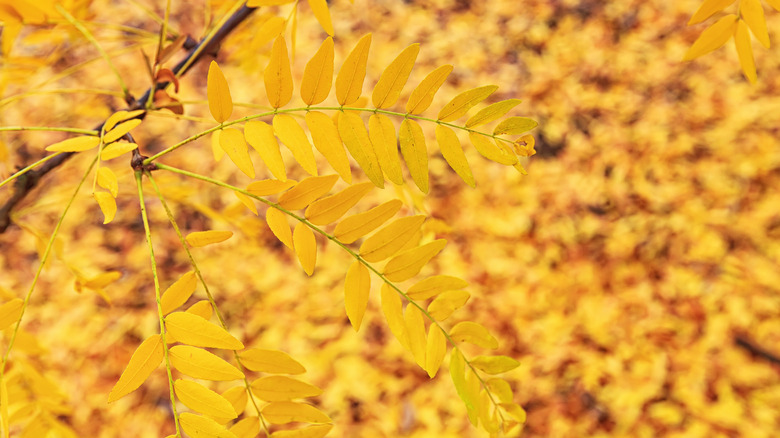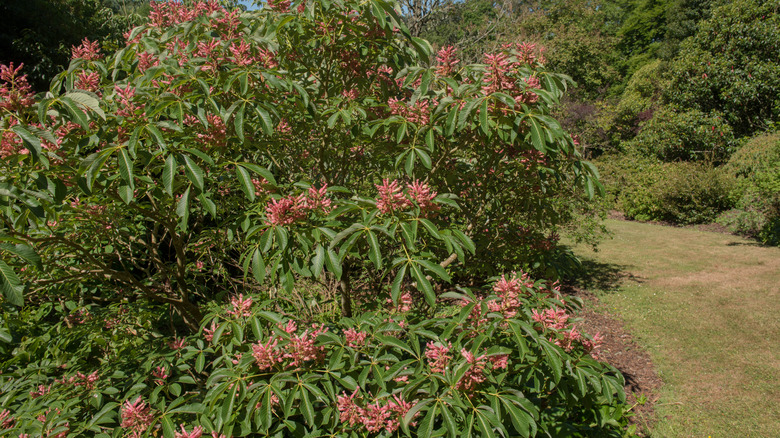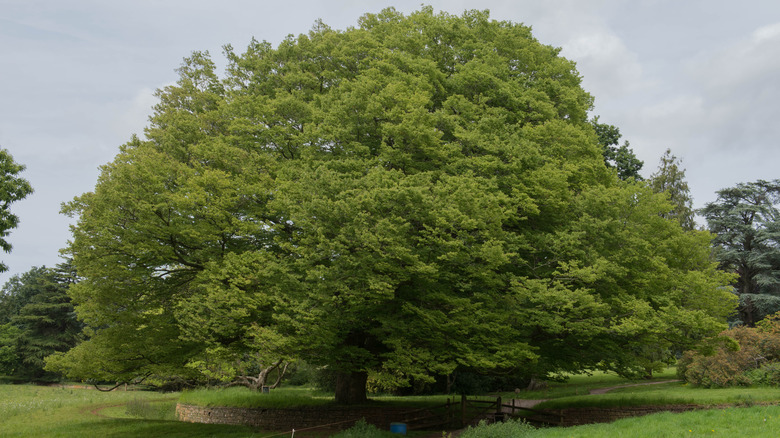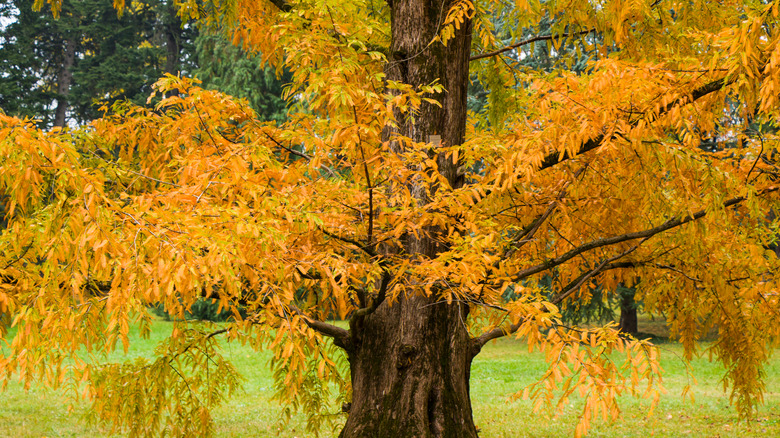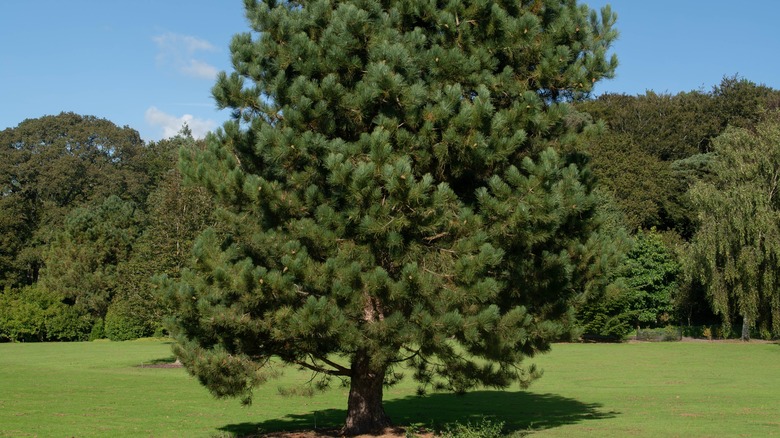15 Drought-Resistant Trees You Should Grow In Your Yard
We may receive a commission on purchases made from links.
Planting trees around the house is rewarding. TreePeople notes how trees are nature-engineered control systems for soil erosion, climatic change, and water pollution. When carefully picked and strategically positioned, they are often an ornament to behold and can equally serve as windbreakers, protecting the home from wind damage. And as you already know, trees come in a variety of shapes, sizes, colors, abilities, benefits, and disadvantages. As such, when picking out trees for your house, you should consider the undesirable traits of the tree, the soil condition, what you intend to achieve with trees, and both the growth rate and form of the trees, per Texas AgriLife Extension Service.
That said, some varieties don't fare as well in dry conditions. If your goal is to build cooling shades perfect for playdates, picnics, and other outdoor activities during the heat waves of summer, but you live in an environment prone to drought, you're in the right place. Below, we will show you 15 drought-resistant trees you should grow in your yard.
Golden rain tree
Also known as the "varnish tree" and "pride of India," the golden rain tree (Koelreuteria paniculata) is a dome-shaped flowering tree that's native to East Asia. Britannica notes it is widely grown in regions with sporadic drought and moderate rainfall. Its clusters of yellow four-petaled flowers and dark green fruit pods are a thing to behold.
Bloom Season: Early June, July
USDA Growing Zone: 5 to 9
Growing Conditions: Full sunlight
Soil Type: Well-drained, acidic, alkaline, loamy, sandy, wet, and clay soils
Size: 30 to 40 feet tall, 35 feet wide
Ginkgo
Hailed by Kew Gardens & Wakehurst as the tree that outlived the dinosaurs, the ginkgo tree (ginkgo Biloba) is a stunning Chinese native tree distinguished by large, round, fleshy seeds. The oldest ginkgo tree was said to have lived for over 3,500 years. The Tree Center said it is best used on the lawn as a shade tree or to create a lovely entrance along the driveway.
Bloom Season: April, May
USDA Growing Zone: 4 to 9
Growing Conditions: Full sun or partial shade
Soil Type: Well-drained, acidic, alkaline, loamy, moist, rich, sandy, silty loam, wet, and clay soils
Size: 50 to 80 feet tall, 30 to 40 feet wide
Blue jacaranda
According to Tribune India, a jacaranda (Jacaranda mimosifolia) is a symbol of wealth, good luck, rebirth, and wisdom. It is a deciduous subtropical tree with smooth, grey-brown bark and mauve-blue or pale indigo bell-shaped flowers reeking of fragrance. PictureThis, however, warns that the blue jacaranda sheds flowers and leaves a lot, and should therefore be planted away from walkways and swimming pools.
Bloom Season: spring, late may
USDA Growing Zone: 9b to 11
Growing Conditions: Full sun
Soil Type: all types of well-drained, rich soil
Size: 25 to 50 feet tall, 15 to 30 feet wide
Kentucky coffeetree
Per the Arbor Day Foundation, Kentucky coffeetree (Gymnocladus dioicus) is an ornamental shade tree that is native to the central states of America and is highly adaptive to drought. It features greenish-white flowers growing in pyramidal clusters and seed pods changing from green to brown through the seasons. North Dakota State University claims that Kentucky settlers who used the seeds of this tree as a substitute for coffee beans were the inspiration behind the name.
Bloom Season: Late May, early June
USDA Growing Zone: 3 to 8
Growing Conditions: Full sunlight
Soil Type: Well-drained acidic, alkaline, moist, rich soil of all types
Size: 60 to 75 feet tall, 40 to 50 feet wide
Pecan
Pecan (Carya illinoinensis) is a native American/Mexican tree that can live up to 300 years, producing dark-green leaves, green tassel flowers, and edible nuts that are used in making traditional deserts, Kidadl writes. Part of the poem entitled "A Pecan Tree" by Juan Olivarez (via Silver Birch Press) reads, "The Pecan tree, he's no one's fool, My papi once told me. As long as the weather still is cool, Not a single leaf, on him you'll see."
Bloom Season: Springtime
USDA Growing Zone: 5 to 9
Growing Conditions: Full sun
Soil Type: Rich, fertile, well-draining soil
Size: 70 to 100 feet tall, 40 to 75 feet wide
Persian ironwood
Persian ironwood (Parrotia persica) is an Iranian native flowering tree that is widely planted in parks and gardens for its beauty, according to Yale Nature Walk. Compared to most drought-resistant trees, Persian ironwood has a fuller appearance (thanks to its smaller split-off branches) and is characterized by dark-red flowers, brilliant deciduous leaves, and smooth patterned bark in white or green. Home & Garden Information Center suggests planting it around the patio or deck as a stand-alone shade.
Bloom Season: Winter
USDA Growing Zone: 5 to 8
Growing Conditions: Full sun or partial shade
Soil Type: Moist but well-drained
Size: 98 feet tall, 26 to 49 feet wide
Purple leaf plum
Guzman's Greenhouse writes that purple-leaf plums (Prunus cerasifera) are moderate-sized non-bearing plum trees with showy bright pink flowers and non-edible fruits. According to the Arbor Day Foundation, they are tolerant of moderate drought and heat and can be habitats for mammals (small or big). Because of their sizes, they are a good option for small yard spaces.
Bloom Season: Early spring
USDA Growing Zone: 5 to 8
Growing Conditions: Full sun
Soil Type: excellent drainage and an acidic to neutral soil
Size: 15 to 25 feet tall, 15 to 20 feet wide
Scotch pine
If you'd love to invite red squirrels and moths into your landscape, grow some scotch pine trees (Pinus sylvestris). The Woodland Trust said they are evergreen trees with scaly orange-brown bark, cones, and needle-like leaves. They are native to northern Europe, where they can live for more than 700 years.
Bloom Season: Spring
USDA Growing Zone: 3a to 8a
Growing Conditions: Full sun
Soil Type: Moist, well-drained soil
Size: 60 feet tall, 40 feet wide
Southern magnolia
Southern magnolia (Magnolia grandiflora L.) is an accent ornamental evergreen featuring massive white flowers with fragrance, smooth leathery leaves, seedpods of large red seeds, and a straight trunk (per Lady Bird Johnson Wildflower Center). In addition, The Pioneer Woman added that planting magnolias is one of the ways to invite birds to your garden.
Bloom Season: May, June
USDA Growing Zone: 6 to 10
Growing Conditions: well-drained acidic soil
Soil Type: Sun or shade
Size: 60 feet to 80 feet tall, 40 feet wide
Weeping bottlebrush
According to the University of Redlands, the weeping bottlebrush (Melaleuca viminalis) is a tropical fruit-bearing tree that is mostly planted for the purpose of adding beauty to a landscape. In the description, this tree has bright red spiky flowers looking like cylindrical brushes; leathery and narrow grey-green leaves; multi-trunked droopy branches; and shaggy dark-grey bark. MasterClass suggests that bottlebrush trees should be strategically planted in the garden to attract pollinators and other beneficial insects.
Bloom Season: Spring, summer
USDA Growing Zone: 9 to 11
Growing Conditions: Full sun
Soil Type: Moist, well-drained soil
Size: 25 to 30 feet tall, 15 to 20 feet wide
Thornless honeylocust
Thornless honeylocust (Gleditsia triacanthos) is a broad, round-shaped, fast-growing tree often planted in suburban landscapes, city parks, and parkways where its lacy foliage offers a dappled shade. The Morton Arboretum added that thornless honeylocust trees are fairly adaptive to drought and all sorts of soil-damaging climatic insults, which is why they are considered durable.
Bloom Season: May, June
USDA Growing Zone: 3 to 9
Growing Conditions: Full sun
Soil Type: Acidic, alkaline, moist, dry, and salty soils
Size: 30 to 70 feet tall, 30 to 70 feet wide
Red buckeye
According to Bernheim Arboretum & Research Forest, the red buckeye (Aesculus pavia), which is on Kentucky's list of endangered plant species, is a shrub-like tree with a dense crown. This tree, with lustrous dark-green leaflets and bright crimson tubular flowers, is said to produce poisonous seeds, which were carried around by native Americans for good luck. The University of Kentucky says it can be planted to invite butterflies and hummingbirds to the home.
Bloom Season: April, May
USDA Growing Zone: 4 to 8
Growing Conditions: Shade or full sun
Soil Type: Moist, well-drained soil (slightly acidic or alkaline)
Size: 15 to 20 feet tall, 15 to 25 feet wide
Japanese zelkova
Canadian Tree Tours describes the Japanese zelkova (Zelkova Serrata) as having narrowly oval leaves, green pea-like fruits, and a medium-sized trunk capped with a wide spreading crown, which makes it the perfect shade. The National Arboretum Canberra claimed that a Japanese zelkova can live more than 1000 years and is native to China, Russia, Korea, Thailand, and Japan.
Bloom Season: Mid-Spring
USDA Growing Zone: 5 to 8
Growing Conditions: Full sun
Soil Type: Deep, moist, well-drained soils
Size: 50 to 80 feet tall, 50 to 85 feet wide
Dawn redwood
Save The Redwoods writes that the dawn redwood (Metasequoia) is a deciduous tree with colorful leaves that was once thought to have gone extinct. In China, the dawn redwood is famously called water pine or water-fir. Despite its name, the Arbor Day Foundation notes that it can withstand some degree of drought. Degreed horticulturist Viveka Neveln (via Better Homes & Gardens) said the dawn redwood can be used to add privacy and cast shade around outdoor living areas.
Bloom Season: Spring
USDA Growing Zone: 4 to 8
Growing Conditions: Full sun
Soil Type: Acidic, loamy, moist, sandy, well-drained, wet, and clay soils
Size: 70 to 100 feet tall, 25 feet wide
Austrian Pine
Per Yale Nature Walk, Austrian pine (Pinus nigra) is a monoecious species with a pyramidal shape, fragrant dark-green needles, wrinkly grey-brown branches, pollen-bearing cones, and rough plate-like bark that can live for up to 500 years. Arbor Valley says it can be grown on the lawn to serve as a windbreak, shelterbelt, and privacy screen.
Bloom Season: May, June
USDA Growing Zone: 4 to 7
Growing Conditions: Full sun
Soil Type: Well-drained acidic, alkaline, loamy, moist, sandy, and clay soils
Size: 50 to 60 feet tall, 20 to 40 feet wide
